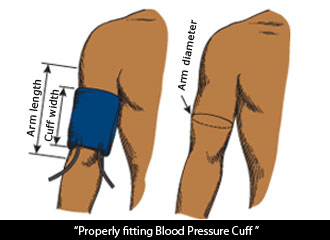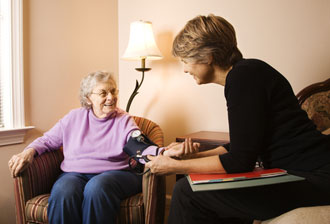What to Do
Preparing the Person before Measuring Blood Pressure
You want to be accurate when taking a blood pressure measurement. Accurate results are useful to the doctor when he or she looks at your care diary. The results may help in making decisions about the person's BP medicines.
Before you measure a blood pressure, have the person relax and be comfortable:
- Have the person go to the bathroom 5 to 10 minutes before the reading.
- Do not let the person exercise, smoke, or drink any caffeine or alcohol within 30 minutes of measurement. Each of these factors raises the blood pressure.
- Have the person relax for 5 minutes before measurement.
- Do not allow the person to talk for the 3 to 5 minutes before the measurement or during the measurement of blood pressure.
How to Monitor Blood Pressure

Follow these tips from the American Heart Association (AHA, 2012):
- Do not apply a blood pressure cuff to an arm if:
- The person has an Intravenous catheter
- The person has a Hemodialysis shunt
- The person has had breast surgery or a stroke on that side
- There is injury, swelling, or disease of the arm
- The arm has a cast or large bandage
- Make sure the cuff fits: measure around the person’s upper arm and choose a monitor that comes with the correct cuff size.
- Be Still - have the person relax to get an accurate reading.
- Have the person place their feet flat on the floor. Do not let the person cross their legs, this causes the blood pressure to rise.
- Support the person’s arm on a flat surface (such as a table) with the upper arm at heart level.
- Make sure the middle of the cuff is placed directly over the brachial artery, which is found on the inside of the elbow, just below the bend of the arm. With your index and middle finger, gently apply pressure until you feel the pulse. It will feel like tapping against your fingers. Do not use your thumb because you may feel your own pulse instead. Check your monitor’s instructions for a picture or have your doctor or nurse show you how.
- Each time you measure the blood pressure, if you think you have a high or low reading, wait 15 minutes and repeat a reading. Record all the results.
- It is important to take the readings at the same time each day, such as morning and evening, or as your doctor recommends.
- If you are taking a blood pressure for the first time, check the blood pressure in both arms. If one arm is reading higher than the other, then the higher arm is the one to use for future measurements. If the difference in arm pressures is greater than 20 mmHg, alert the home health nurse, or the person’s doctor.

Unexpected Blood Pressure Results
Be sure that when you begin to monitor blood pressure at home that you have talked to the doctor and know when to call about unexpected results or how to manage them at home.
Blood pressure reading is above the acceptable range
- Repeat in other arm and compare.
- Make sure the cuff fits correctly.
- Is the person having any symptoms of high blood pressure?
- Headache
- Flushed face
- Nosebleed
- Sleepiness in older persons
If any of these signs or symptoms are present, contact the home health nurse, doctor, or emergency services promptly.
Blood pressure reading is below acceptable range
- Repeat measurement in the other arm and compare
- Make sure the cuff fits correctly
- Is the person having any symptoms of low blood pressure?
- Dizzy or fainting
- Fatigue
- Confused
- Skin is pale, bluish, or cool
- Place person flat if they can tolerate position
If any of these signs or symptoms are present, contact the home health nurse, doctor, or emergency services promptly.
Blood pressure reading could not be obtained or was difficult to hear
- Check all equipment for proper connections and function
- Cuff is probably too loose, too big, or stethoscope may be in wrong place.
- Try measuring in the opposite arm
- At times, the ear tips of the stethoscope are not properly placed in the ear. If this happens, you may hear little to no sounds coming from the stethoscope. When the ear tips of the stethoscope are in your ears, they should point away from you, or point forward. If the fit isn’t comfortable, or you cannot hear, readjust the headset/eartips for a better fit.
Older Adults
Older adults may not have as much muscle on their arm. In addition, their skin is more fragile and their blood pressure changes more easily. For older adults consider:
- Careful choice of cuff to fit their arm
- Check their skin frequently and alternate arms for frequent blood pressure checks
- Do not measure blood pressure shortly after a meal because it may be lower just from eating
- Measure blood pressure after the person has rested for five minutes
Eat Healthy
The doctor will often have a person with high blood pressure follow a special diet. One diet that many with high blood pressure follow is called the DASH diet.
DASH stands for Dietary Approaches to Stop Hypertension. The DASH diet is an eating plan which is low in fat, but rich in low-fat dairy foods, fruits and vegetables. The diet is also low in salt or sodium, usually with a limit of 2 to 2.4 grams of sodium a day.
Care of a Stethoscope
A stethoscope requires proper care for best function.
- Remove the earpieces regularly and clean off any earwax.
- Clean the diaphragm of dust, lint, and body oils by using an alcohol pad.
- Clean the tubing weekly using a washcloth moistened with mild soap and water. Rinse off and dry thoroughly.
- Do not place a stethoscope in water